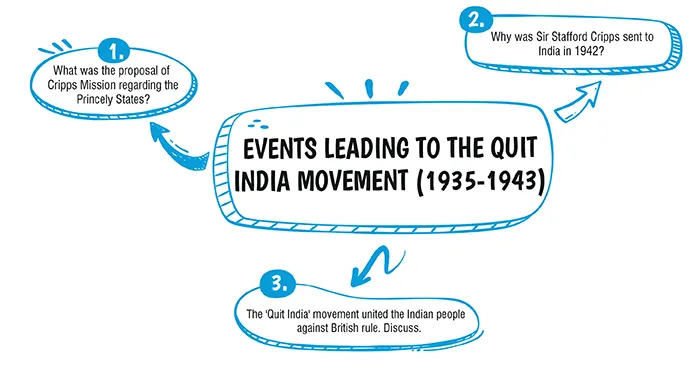Home / Board / ICSE / important Questions / Class 10 / History & Civics / Events Leading to the Quit India Movement (1935-1943)
Table of Contents

Ans. (c) Muslim League, the Communist Party of India and the Hindu Mahasabha support the movement.
Explanation:
Muslim League, the Communist Party of India and the Hindu Mahasabha did not support the “Quit India Movement” movement.
Ans. (a) Running underground Movement against British Rule.
Explanation:
Aruna Asaf Ali (née Ganguly; 16 July 1909 – 29 July 1996) was a prominent figure in India's history, known for her roles as an educator, political activist, and publisher. She played a crucial part in the Indian independence movement and is especially renowned for her courageous act of hoisting the Indian National flag at the Gowalia Tank maidan in Bombay during the Quit India Movement of 1942. Her contribution remains etched in the annals of India's struggle for freedom.
Explanation:
The Princely States would be free to join the Indian Union or to stay out.
Explanation:
Sir Stafford Cripps was sent to India to break the political deadlock between Indian leaders and the British Government.
Explanation:
On 8th August 1942, Mahatma Gandhi launched the Quit India Movement at the session of the All-India Congress Committee in Mumbai. Gandhiji gave the call “Do or Die” in his speech.
Rise of Nationalism:
i. A greater sense of unity and brotherhood emerged due to the Quit India Movement. Many students dropped out of schools and colleges, people gave up their jobs and withdrew money from the banks.
ii. Women Participation: Women took active participation in the movement. Female leaders like Usha Mehta helped set up an underground radio station which led to the awakening about the movement.
iii. Rise of Future Leaders: Underground activities were taken by leaders that included Ram Manohar Lohia, J.P. Narayan, Aruna Asaf Ali, Biju Patnaik, Sucheta Kriplani, etc which later emerged as prominent leaders.
iv.It changed the nature of politics with the British, ultimately paving the way for India's independence.
v. The great significance of this historic movement was that it placed the demand for independence.
Download Mind Map of this chapter
Download NowWant to Practice Mock Tests of this chapter
Practice NowDownload Important Questions of this chapter
Download NowCBSE Important Questions Class 10
ICSE Important Questions Class 10
CBSE Important Questions Class 10
ICSE Important Questions Class 10